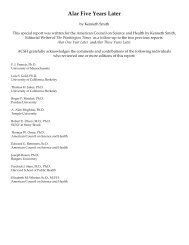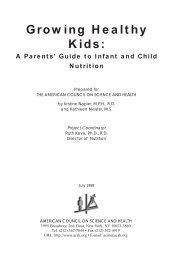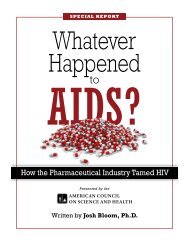The Role of Beef in the American Diet - International Meat Secretariat
The Role of Beef in the American Diet - International Meat Secretariat
The Role of Beef in the American Diet - International Meat Secretariat
You also want an ePaper? Increase the reach of your titles
YUMPU automatically turns print PDFs into web optimized ePapers that Google loves.
<strong>The</strong> <strong>Role</strong> <strong>of</strong> <strong>Beef</strong> <strong>in</strong> <strong>the</strong> <strong>American</strong> <strong>Diet</strong><br />
36<br />
product label or consult <strong>the</strong> producer <strong>of</strong> <strong>the</strong> meat.<br />
Unlike “natural,” <strong>the</strong> term “organic” does have an <strong>of</strong>ficial def<strong>in</strong>ition.<br />
As <strong>of</strong> October 2002, <strong>the</strong> U.S. Department <strong>of</strong> Agriculture has established<br />
standards that food labeled “organic” must meet (83). In a booklet<br />
for consumers, <strong>the</strong> USDA expla<strong>in</strong>s <strong>the</strong> mean<strong>in</strong>g <strong>of</strong> organic as follows:<br />
Organic meat, poultry, eggs, and dairy products come from animals<br />
that are given no antibiotics or growth hormones. Organic<br />
food is produced without us<strong>in</strong>g most conventional pesticides,<br />
petroleum-based fertilizers, or sewage sludge-based fertilizers;<br />
bio-eng<strong>in</strong>eer<strong>in</strong>g; or ioniz<strong>in</strong>g radiation. Before a product can be<br />
labeled “organic,” a Government-approved certifier <strong>in</strong>spects <strong>the</strong><br />
farm where <strong>the</strong> food is grown to make sure <strong>the</strong> farmer is follow<strong>in</strong>g<br />
all <strong>the</strong> rules necessary to meet USDA organic standards.<br />
Companies that handle or process organic food before it gets to<br />
your local supermarket or restaurant must be certified, too. (83)<br />
Thus, beef labeled “organic” has been produced <strong>in</strong> ways that differ<br />
from <strong>the</strong> conventional ones <strong>in</strong> several respects. However, this does not<br />
necessarily imply that it is a safer or more nutritious product. In fact, as<br />
<strong>the</strong> USDA explicitly states:<br />
USDA makes no claims that organically produced food is safer or<br />
more nutritious than conventionally produced food. Organic food<br />
differs from conventionally produced food <strong>in</strong> <strong>the</strong> way it is grown,<br />
handled, and processed. (83)<br />
Consumers sometimes th<strong>in</strong>k that beef labeled “organic” or “natural”<br />
is better than conventionally produced beef <strong>in</strong> that it is less likely to<br />
conta<strong>in</strong> illegal residues <strong>of</strong> various chemicals. However, <strong>the</strong> scientific<br />
evidence <strong>in</strong>dicates that <strong>the</strong> products do not differ <strong>in</strong> this regard. In two<br />
studies conducted at Colorado State University, large numbers <strong>of</strong> samples<br />
<strong>of</strong> “natural,” “organic,” and conventionally produced beef (both<br />
muscle meat and organ meats) were tested for a variety <strong>of</strong> drugs used <strong>in</strong><br />
beef production, pesticides, and o<strong>the</strong>r contam<strong>in</strong>ants. In <strong>the</strong> first study,<br />
no violative residues <strong>of</strong> any k<strong>in</strong>d were found <strong>in</strong> any <strong>of</strong> <strong>the</strong> samples (84).<br />
In <strong>the</strong> second study, no violative drug residues were found. However, a<br />
small number <strong>of</strong> <strong>the</strong> samples conta<strong>in</strong>ed residues <strong>of</strong> pesticides <strong>in</strong> excess<br />
<strong>of</strong> government standards (85). <strong>The</strong>se residues were found <strong>in</strong> 0.002% <strong>of</strong><br />
conventionally produced samples, 0.004% <strong>of</strong> “natural” samples, and<br />
0.004% <strong>of</strong> “organic” samples, and all <strong>of</strong> <strong>the</strong> affected samples were liver,<br />
not muscle meat.










